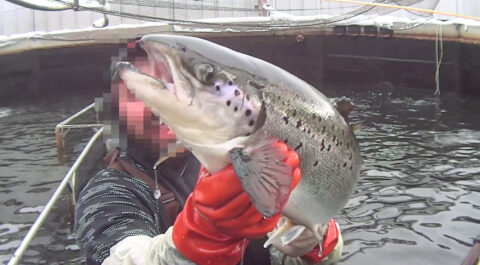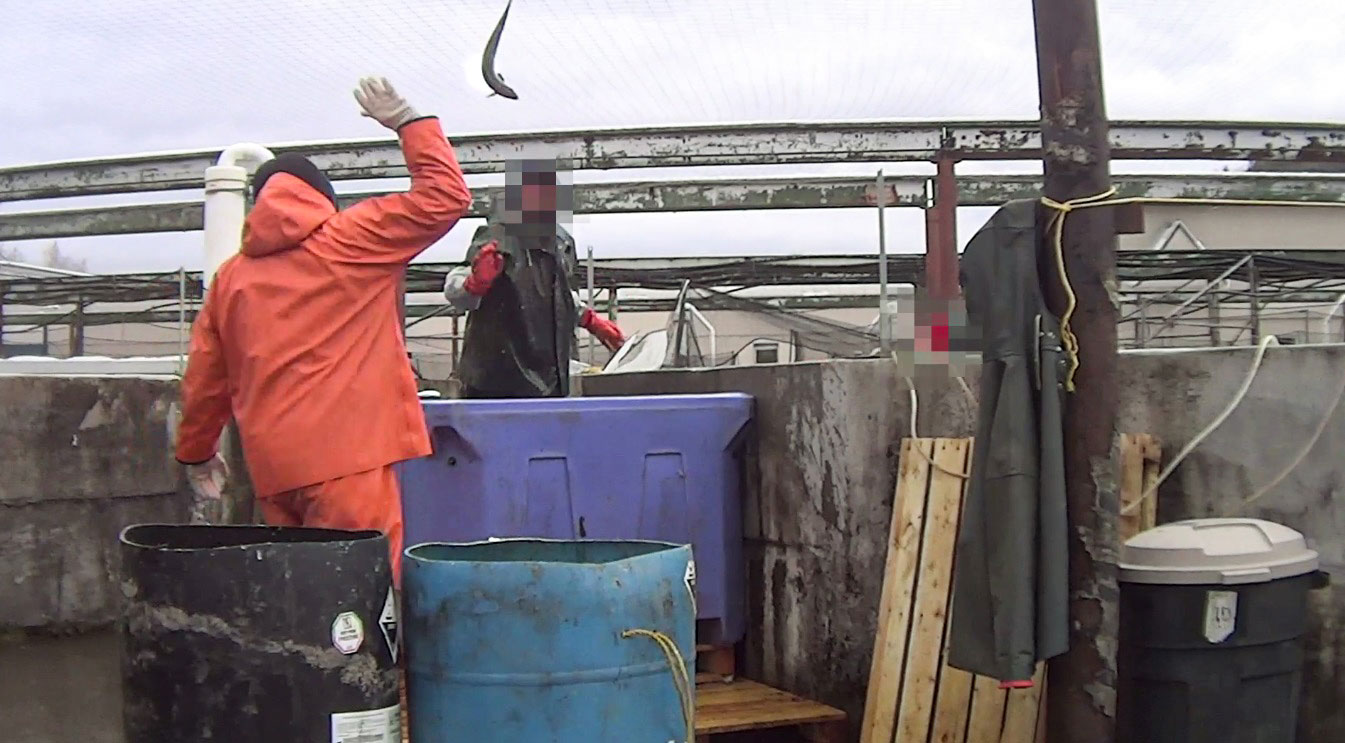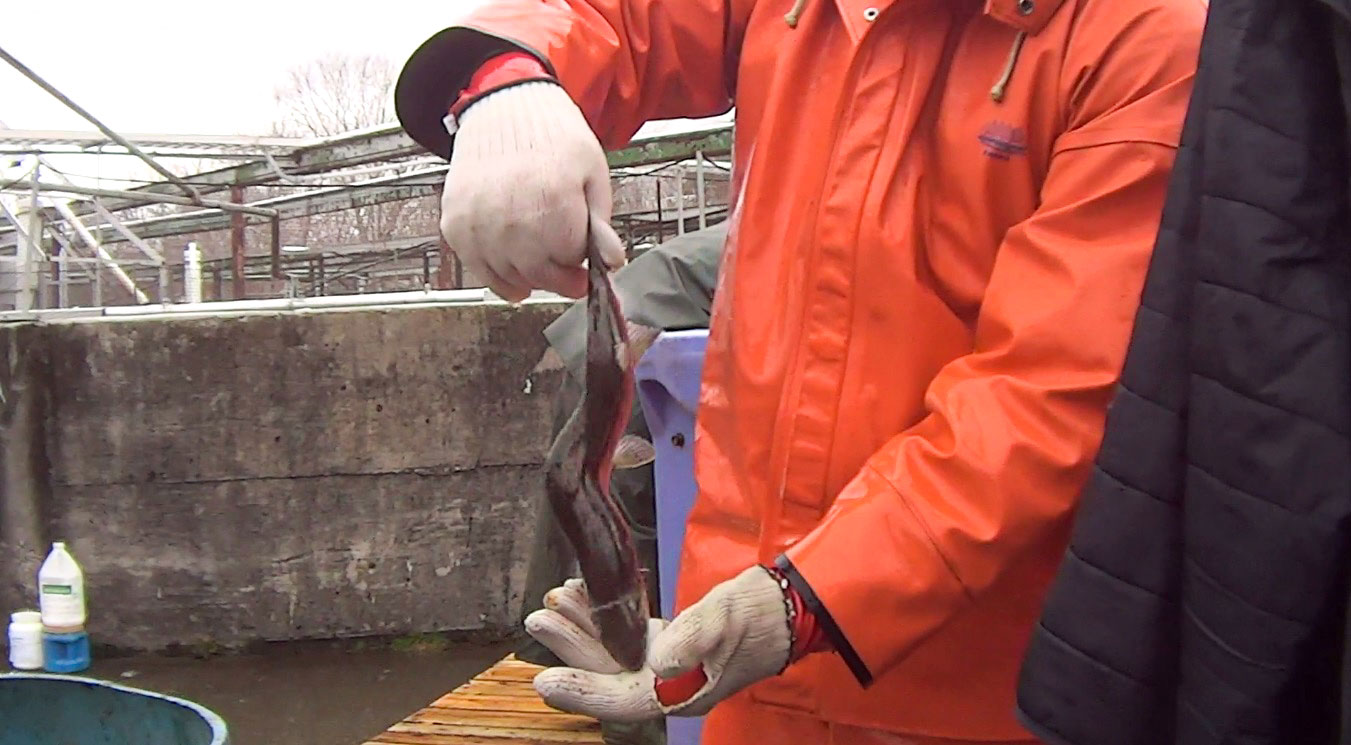Perspective
Critics Declared Veganism Dead in 2025. Here’s What Those Obituaries Are Missing.
Food•5 min read
Reported
Groundbreaking undercover investigation of salmon aquaculture exposes cruel, filthy practices of the industrial fish farming industry.


Words by Krista Kihlander
To the average consumer, a diet consisting of fish in place of other types of meat is often perceived as the happier, healthier choice. But happier and healthier for whom? Just as land animals suffer by the millions on factory farms, so do fish.
Today, veteran animal rights organization Animal Outlook, formerly Compassion Over Killing, released the first-ever undercover footage of a salmon aquaculture farm. The footage reveals heinous scenes of animal abuse, giving consumers a first look into the highly secretive salmon farming industry.
Fish are intelligent, wild animals. They think, use tools, have personalities, and feel pain very similar to the way we humans do. According to biologist Lynne Sneddon, who first discovered fish possess nerves known to convey pain in 2002, humans’ ability to feel pain is likely derived from one of our fish-like ancestors.
“The science on fish sentience is clear: fish have the capacity to suffer and feel pain,” said scientist Becca Franks, who teaches animal welfare and behavior courses at New York University. Despite their capacity to suffer, fish are farmed more than almost any other food animal on the planet.
Approximately half of the global fish production comes from fish farms. The industry continues to grow at rates (5.8%) faster than other major food production sectors. In the United States, anywhere from 2-5 million Atlantic salmon and 238-580 million total fish are raised on factory farms every year.
Like nearly all farmed animals, fish around the world have little to no legal protection. They live and die in crowded, parasite-infested tanks, all so that we humans can eat fish. This gross neglect leads to torturous living conditions, physical ailments, disease, and all-around horrid conditions for fish to live in.

The first-of-its-kind undercover investigation exposes systemic animal abuse and disgusting conditions at Cooke Aquaculture, a massive salmon hatchery whose subsidiary, True North, has partnered on a new seafood brand with Martha Stewart.
In addition to the Martha Stewart for True North Seafood product line, the company is also a supplier to wholesale restaurant supplier Samuel and Sons Seafood, Central Market, QVC, and others.
Martha Steward for True North Seafood is distributed through Amazon.com and various specialty retailers around the world.
The fishing industry is scrambling to find alternatives for catching wild fish as the oceans are being threatened by overfishing, bycatch, and pollution. While aquaculture, more commonly known as fish farming, may seem like a simple solution, it is not.
“While the aquaculture industry sells itself as a solution to the state of our overfished oceans, there’s a big catch: Millions of farmed fish are languishing inside filthy tanks, and disease and pollution from fish factory farms take a toll on wild populations, too,” said Mike Wolf, Director of Investigations at Animal Outlook. “It’s long past time the fish farming industry is put on the hook for the suffering it’s forcing upon animals.”
Animal Outlook’s experienced investigator spent months undercover at a Cooke Aquaculture hatchery in Bingham, Maine. Cooke Aquaculture is currently operating in the United States, Canada, Chile, Scotland, and Spain.
The brand boasts about producing Atlantic salmon that is “sustainably-farmed in the clear waters of the Gulf of Maine.” That could not be further from the truth. Animal Outlook’s investigation revealed murky, overcrowded tanks full to the top with diseased and dead fish.
Cooke Aquaculture is listed as a Best Aquaculture Practices (BAP) certified company, a supposedly rigorous and accountable auditing process. The main focuses of this accreditation process are the environment, social responsibility, animal welfare, food safety, and traceability.
BAP also lists several standards for salmon farms that the Cooke hatchery violated, specifically those relating to animal welfare. The most notable and blatantly dismissed standards, according to the investigative footage, are:
Note: These are only three of the standards in one of the 12 different categories laid out in the BAP’s salmon farm regulations. They provide a framework for what “exceptional” practice looks like in the industrial fishing industry. But as the footage shows, BAP’s standards were virtually nonexistent at Cooke Aquaculture.
The life of fish at Cooke Aquaculture is dismal – and the employees know it. “He’s just gonna suffer until he’s fucking dead,” said one employee on video.
The investigation further revealed blatant cruelty by Cooke Aquaculture employees. Workers can be seen slamming and stomping on fish, taking “trick shots,” and violently throwing fish between piles. As a result, fish suffer crippling injuries and death.
The hatchery’s foul environment is also a perfect breeding ground for parasites. Animal Outlook’s investigator documented fungus eating away at the faces of fish. Some even lost an eye. To combat diseases and a rise in fish deaths, fish are vaccinated. During the vaccination process, fish are improperly anesthetized and handled in a rushed manner. Fish often convulse in pain during this harsh procedure. In trying to subdue the fish, workers often end up injuring their spines.
The fish receive no medical treatment after their spine is injured or broken, and the healing process is extraordinarily painful. Spinal injuries leave the affected fish abnormally contorted in the middle of their bodies, like a poorly drawn letter Z.

Once a fish is deemed “unfit” for human consumption, the workers dispose of their body in a multitude of ways, each disturbing and unnecessarily violent. This investigation shows workers beating and slamming fish on the ground or against other hard objects in an attempt to kill them, although the fish are still seen moving around after these hits.
Other fish are weeded out of the massive tanks and tossed haphazardly into buckets containing dying and dead fish. In these buckets, the “lucky” ones are dead before being thrown in, while others suffocate beneath hundreds of struggling fish, suffering immensely in their final moments of life.
In this unnatural environment, many salmon at the hatchery don’t even survive long enough to be sent to slaughter at another facility. Animal Outlook’s investigator documented a worker saying, “Hopefully by Monday morning, all the fish aren’t dead in here.”
Animal Outlook has submitted evidence to authorities and is urging prompt enforcement action.
After being contacted about Animal Outlook’s investigation, Cory Baker, COO of Marquee Brands, which owns the Martha Stewart True North Line, replied right away, stating that the company will be opening its own investigation immediately and is committed to “sustainability and of course ensuring cruelty free practices.”
This is the reality of farming fish for food. Spread the word.